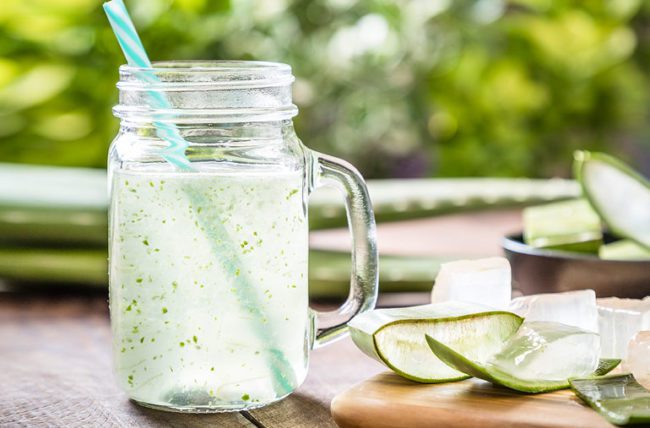Aloe Vera: How to Use and Health Benefits

Aloe Vera
Learn about the benefits of aloe vera and how to use it effectively, including how to eat it and what aloe vera is used for.
Aloe Vera products are made from the entire leaf of the plant. Aloe vera is a miracle plant that helps reduce inflammation, has antibacterial properties, and can be used on the outside of your body – your skin and hair – as well as the inside, where eating it or drinking the gel can help with digestion.
What is Aloe Vera used for?
Sunburn relief, moderate skin irritation or inflammation, hair moisturization, bug bite relief, natural lubricant, a natural shaving cream alternative, and make-up removal are all benefits of aloe vera. It’s also used as a flavouring in meals and to prevent tooth decay.
The succulent’s leaves hold water as well as other nutrients. According to a study published in the International Journal of Research and Medical Sciences, while the majority of the leaf is water (99 percent), it contains roughly 75 active chemicals.
What’s the history of Aloe Vera?
Aloe vera has been used to treat burns and wounds in Chinese and Egyptian cultures for over 6,000 years, and it is currently one of the most researched plant-based remedies.
What’s the best way to use Aloe Vera?
Aloe vera can be found in a wide range of goods, from shampoo to lotions to dishwashing solutions, but the dosage varies greatly. Use fresh aloe if you want to be sure you’re getting the most out of it. Aloe vera leaves can be found in some supermarkets and health food stores. Cut the leaf in half horizontally and scoop out the gel with a spoon. This gel can be applied straight to the skin to relieve sunburn or soothe sensitive skin. You can also use it to add thickness and shine to washed hair by applying it directly to it and letting it dry (it will feel crunchy at first, but you can run your fingers through your hair to remove that, leaving your hair soft and shiny).
Can you eat Aloe Vera?
Yes, aloe vera may be eaten. You can consume the skin by soaking it in water for 10-20 minutes before eating it to ensure it’s soft enough to eat. The gel inside the leaf, on the other hand, is commonly consumed in smoothies or other similar drinks.
To eat it, cut the aloe leaf in half and remove the gel. Rinse off any yellow ‘latex,’ which is a material that is released between the skin and the gel and can taste bitter, cause laxative symptoms, and cause kidney problems. The remaining gel can be added to cereal or porridge or blended into your favourite drink.
Does Aloe Vera really work?
When applied to inflamed or sun-damaged skin, aloe vera works as an anti-inflammatory. It’s also hydrating.
Drinking aloe vera juice, according to research published in The Journal of Alternative and Complementary Medicine 3, can assist diabetics lower their fasting blood glucose levels. Twice a day, add 1 spoonful of aloe to a drink.
Aloe vera can also aid in the prevention of tooth decay. It was proven to be helpful at eliminating dangerous germs in the mouth, according to research published in General Dentistry 2. To reap the benefits, ask your dentist for a toothpaste that contains aloe, as the aloe it contains must be processed in a specific way.
How long does Aloe Vera take to work?
If you use aloe vera to treat sunburn, you should notice immediate relief because the gel has an instantaneous cooling impact. The effects of changes in blood glucose levels in diabetics will take longer to notice – the effects were noticed after two to three months in the study cited above.
Where can I get Aloe Vera?
The beauty of aloe vera is that it’s simple to grow and maintain. They don’t require much water – once every two or three days (watering thoroughly) is plenty – but they do best when kept indoors. Fresh leaves are also available in many supermarkets and health food stores. Aloe vera products can also be found in pharmacies and health food stores, and there is a wide range of options available online. Check the list of ingredients on aloe vera products to be sure it’s mostly aloe vera and not just other substances. Also, unless an aloe vera product is labelled as a food product, you should avoid eating it. Preservatives have been added to cosmetics, for example, to extend shelf life while also adjusting the colour, texture, and scent of the product.
What are the side effects of Aloe Vera?
The majority of the aloe leaf is edible, but cutting it may reveal a yellow material that has a strong laxative effect and may cause renal problems. As a result, it’s best to rinse off any part of the leaf you consume to ensure there’s no yellow latex present.
Are there any contraindications when taking Aloe Vera?
Aloe vera can cause allergic contact dermatitis in certain people. High amounts might also induce stomach issues. Before consuming aloe vera, check with your doctor if you’re on any drugs for blood diseases, diabetes, or digestive problems.




